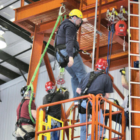This article will cover the steps required to create an emergency response plan. It is important that your team understands what they should do when an emergency occurs.
Step 1: First, perform a risk assessment
A comprehensive risk assessment is the first step in creating an emergency plan. This will help you identify potential threats to your business. Employees need to be aware of possible emergencies near their workplaces or other events, as well as the actions they should take. You may need to plan for the following events:
- Natural Disasters (hurricanes and tornadoes as well as earthquakes, earthquakes, wildfires, etc.
- Severe Weather (winter storms, high winds, and extreme heatwaves), etc.
- Infectious diseases and pandemics (COVID-19), influenza, etc.
- Facility emergency (structure fires and hazardous leaks or spills etc.
- Acts Of Workplace Violence (active shooters and bomb threats, terrorist attacks, etc.
- Civil disturbances (protests, demonstrations, riots, strikes, etc.)
Step 2: Contact information
If you have an emergency that could result in physical harm to your employees or your property, your first call should be to your local emergency response team. You should also have numbers for emergency medical service (EMS), fire department and local law enforcement/police departments readily available.
Also, ensure you have the emergency contact information for all employees in case one is lost or becomes injured.
Step 3: Assign roles to employees
Employees will turn to their leaders when they experience an emergency. They should also be responsible for activating your emergency response plan, answering any questions, and ordering evacuations if necessary. There are important things to remember when assigning roles. It is important to ensure that your response team can quickly respond to an emergency. These are the roles that you should create as part of an emergency response plan.
- Incident commander
- Assistant incident commander
- Scene supervisor
- Building utility Manager(s)
- Route guide(s)
Step 4: Take stock and evaluate the current resources in your organization
Are you familiar with the office alarm systems and fire extinguishers? Have you ever looked at your first aid kit, first aid kits, and alarm systems lately? These essential components are crucial to any emergency response plan and should be inspected regularly.
- Fire extinguishers
- Alarm systems
- First aid kit
Step 5: Create an evacuation plan
Evacuating a building or premises during an emergency is a common requirement. Your business should have a plan of evacuation that includes primary and secondary escape routes. All exit routes and fire escapes should be marked with signs. You should keep these exit routes clear of any furniture or other obstructions that might hinder employees’ ability to escape. Large offices should have multiple floor plans and diagrams. Post them to let employees know which evacuation routes are available. A separate evacuation plan should be developed for people with disabilities, who may require additional assistance. This is best practice. Additionally, provide employees with fall protection training to deal with evacuation.
Step 6 – Decide how employees will communicate with the business.
Communication is perhaps the most crucial part of an emergency response plan. It is important to plan how you will notify employees about a critical event. How the information will be received and delivered? What communication channels will work best to reach every employee who is in danger?
How to Choose a CPR Training Provider?
Do you work for an employer that is interested in comparing the first aid training providers?
You are legally responsible for providing first aid equipment and facilities if you are. You must also ensure that employees have access to medical care if they become ill or injured at work.
Step 1: Assessment of First Aid
You should conduct a first-aid need assessment to determine the equipment you require. Consider the hazards and dangers in your work environment. HSE recommends you think about:
- The nature of your work
- Workplace hazards and risks, including specific hazards that require special arrangements
- The nature and size of your workforce
- Your staff’s work habits
- Holidays and other absences for those who will serve as first-aiders or appointed persons
- Your organization’s accident history
Step 2: Select potential First-Aid Training Providers
Next, you will need to narrow down first-aid training providers. The First Aid Training Co-operative makes it easy to fulfill your company’s legal requirements. There are many options available to you, including our vast array of public and private courses.
Our First Aid & CPR trainers in Mississauga are highly qualified, friendly, and experienced and make our courses memorable and easy to use. We have years of experience and outstanding feedback from our clients, making First Aid Training practical, useful, and most importantly, life-saving. There are various first aid and CPR training providers who provide forklift training, and fall protection training in Mississauga.
Step 3: Due Diligence
The HSE has stopped issuing “training numbers” to first aid training businesses since October 2013. Employers who require first aid training must now ensure that the provider they choose is qualified. This is called ‘Due Diligence.
Step 4: Arrange training
Final step: Book your training knowing that you have met all legal requirements. Contact the best first aid & CPR training provider in Mississauga for fall protection training, first-aid training and much more.





